Selling products directly via social media is on the rise globally. Providing a frictionless and focused customer experience, where users can discover, research, and make a purchase without leaving social media is a powerful strategy for increasing your sales.
The social media industry is preparing for an acceleration of social commerce growth, as key platforms advance their shopping and checkout capabilities. From 2021 Statista data, 11% of social media users made an immediate online purchase after discovering a product, while 44% made a purchase later.
The global Covid-19 pandemic has also accelerated social commerce, with many users turning to platforms like Instagram and TikTok to research and make purchases. Emarketer’s ’Social Commerce 2021’ report estimates that the number of US social commerce buyers grew to 80 million in 2020 and will increase to 96 million in 2022.
There are also plans from platforms such as Instagram to encourage more in-app purchases by offering features so users can save payment details, and check-out pages are simplified. Let’s dive into the world of social commerce to see how it can help your business drive sales and revenue.
How does social commerce work?
If your business sells physical goods, then integrating social commerce to power up into your strategy is essential. It eliminates any barriers to purchasing, such as slow website loading times or complicated user journeys.
A large amount of purchasing on social media is driven by impulse buying, especially if the price is available. During Q2 of 2021, Statista reported the average value of online orders referred through social media was $81.05.
It works by a user simply seeing an item they would like to purchase, such as a pair of sunglasses, and clicking ‘shop now’ or ‘buy now’ to complete the purchase. The price, description and delivery information will all be visible within the social platform, meaning there is no need to even visit the retailer’s website.
User-generated content, created by customers and influencers, combined with social commerce features such as shoppable tags and links, leads to an increase in impulse purchases. This increase is motivated by lifestyle and emotion. Users are looking for social proof that the products are credible, well-made and recommended by people they respect or admire.
What platforms offer social commerce?
Within the next three years, Statista anticipates that 8 in 10 ten US businesses anticipate will sell on social media which just shows the value of these networks as a sales channel.
Social commerce is currently available on Facebook, Instagram, TikTok, and Pinterest. In 2022, YouTube is also testing capabilities of adding shoppable tags and links to video content.
Users can create a shop within social media if they use a professional account. This is something that can be switched over to from a personal account, in the settings menu.
Social commerce on Facebook and Instagram works in a similar way; you can tag items from your shop in your photos and videos. On Instagram, this includes Stories and Reels content.
When people see your products tagged in your posts, they can select those tags to find out product details including name and price. When they click on these tags they will be taken through to your shop in the platform to find out more detail, and purchase. See the example below on Instagram where hovering provides product information.
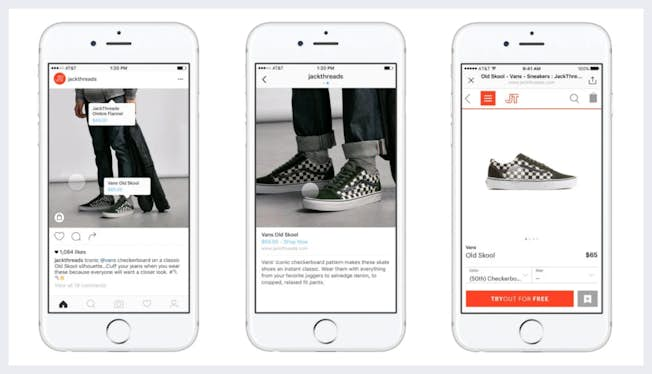
Currently, users will see the option to purchase the product on your website – but Meta is testing in-app purchases currently in the US. You can tag products while creating a new post or tag products in an existing post. You can tag up to 30 products in a post, but this would look busy and complicated so no more than 10 tags are recommended per post.
Some brands on social commerce
The brand, ‘Not on the High Street’, uses Facebook shopping to tag products within posts on its Facebook Page.
This means the brand can showcase seasonal items easily around key retail dates such as Easter, Christmas, Mother’s Day, and Ramadan, while allowing users to see pricing and find the exact landing page to purchase on their website.
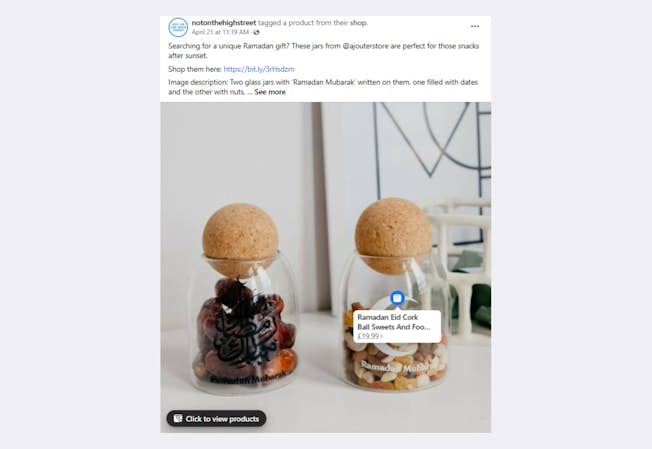
Scandiborn uses shoppable tags on Instagram to tag their products into customer UGC which they are sharing across posts and Stories. This allows them to showcase to potential customers how their products look in a lifestyle setting.
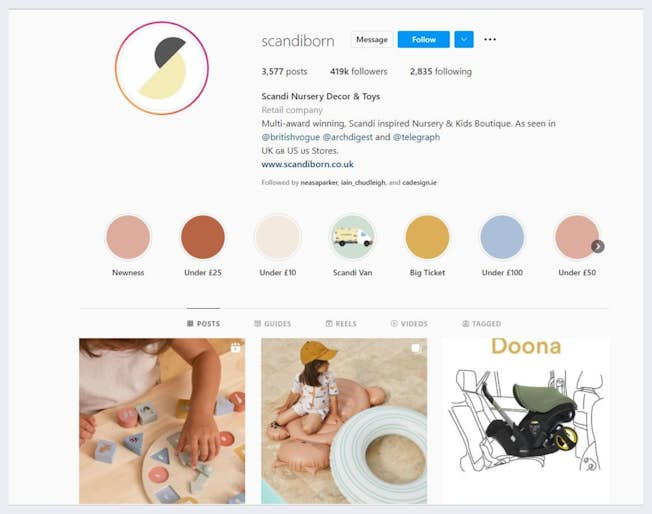
On TikTok, users can add a shopping tab to their TikTok profile, as long as they are using Shopify as their ecommerce platform. Shopify merchants can add the tab which pulls products from their Shopify product catalogs, allowing other TikTok users to browse products without leaving the app and easily navigate to the relevant online stores for checkout.
TikTok Shopping is only available to Shopify merchants with a TikTok for Business account in the USA and UK. The feature is being tested in other countries at the moment before a global rollout expected later in 2022.
Kylie Cosmetics uses social commerce on TikTok, with a shop tab on its profile for users to scroll through the latest products on. Products are also tagged in TikTok videos.

On Pinterest, shopping tags are powered by a type of Rich Pin called a Product Pin. These feature products that are available to buy from the merchants listed in the Pins. Some product Pins will direct you to the retailer’s website and others will allow you to purchase products from retailers without leaving Pinterest.

If you're in the US and can see a Buy button below a Pin, you'll be able to complete your purchase via a checkout experience without leaving Pinterest. You can currently only check out products on your iOS or Android device.
Who can use social commerce?
Businesses can only sell physical products using social commerce, so events, digital products and services are not eligible, for now at least. Although Meta is trailing in-app purchases on its social virtual reality app Horizon Worlds.
Each social media network also has its own set of merchant guidelines for any business wanting to sell using their sites. There are several things you cannot sell in social media including
- alcohol
- some healthcare products
- digital products
- event tickets
- subscriptions
You can check the merchant guidelines for each social media network by Googling.
Apparel/accessories remains the largest category for social commerce, but consumer electronics, cosmetics, home decor, and consumer goods are also key players.
Brands featuring “new and differentiated products and/or aspirational imagery are best suited for the social commerce environment”, according to eMarketer.
In some cases, an item may be rejected by the social media platform, due to changing rules or errors in algorithms picking up on certain words in product descriptions. If a product is rejected and is not listed within your shop, the platform will notify you as to why. They will also offer an opportunity to appeal the decision.
How do I set up social commerce?
Each social media platform works differently for social commerce so it’s important to familiarize yourself with each one you’re considering for selling. Before you start, have a look at our walkthrough guide on social media shopping to see how each platform works.
Social commerce setup on Instagram & Facebook
Although the platforms are different, the commerce set-up is the same through Meta. Instagram and Facebook Shopping is powered by a single catalog which enables you to manage your inventory and sales.
You can create your catalog within Commerce Manager in your Meta Business Suite. The catalog can be uploaded manually, by inputting product names, images and descriptions.
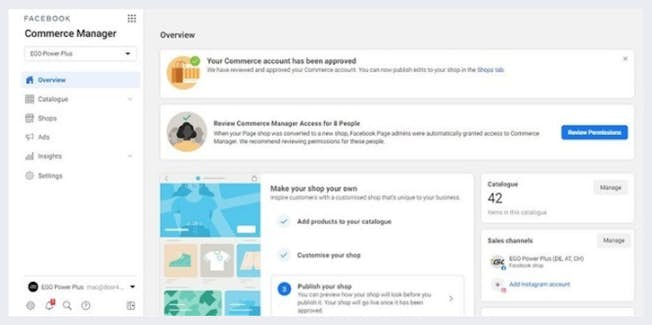
Alternatively, if you host your products on a partner platform that can integrate with Facebook, you can import them to a Facebook catalog. Platforms such as Shopify, WooCommerce and Big Commerce are supported.
You can then continue managing your products on your partner platform and your updates will sync to Facebook on a regular basis. There is a complete list of third-party tools which can be integrated into Meta Business Suite here.
Social commerce setup on Pinterest
93 percent of people use Pinterest to plan purchases so it’s a valuable platform to promote products.
The network’s social commerce is powered by Rich Pins which are SEO-focused. These work by displaying metadata from marked up pages on your website and come in four types:
- Article Pins —This refers to blogs or articles and consists of a headline, author, and description.
- Product Pins — This is for selling products and includes information such as pricing and availability.
- Recipe Pins - This is for recipes and includes information for a Pinterest user about ingredients, cooking time and ratings in-app
- App Pins - These enable a user to install your app directly from Pinterest
Once you've applied for Rich Pins, any content on your site with metadata will turn into a Rich Pin when a user saves it. Apply for Rich Pins via the Pinterest help pages and add relevant mark up to your website. If you use Shopify, these websites already use the correct metadata.
Social commerce setup on TikTok
TikTok keeps hitting the headlines and gaining new users as a platform on the rise. TikTok Shopping is only available to Shopify merchants with a TikTok for Business account.
Early access to TikTok Shopping has been granted to merchants in the US and UK. How it works is that a ‘Shop’ tab is added to the TikTok profile (like in the example for Kylie Cosmetics above). This tab will pull products from Shopify’s product catalogs and allow TikTok users to look at products in-app and checkout on the creators’ online store.
As one of the testers for TikTok Shopping, beauty retailer JustMyLook used TikTok to sell on Black Friday in 2021 and saw 102 percent increase in net revenue.
Users can apply for early access through Shopify’s TikTok channel or find out more about it here.
How do I optimize my social shop to encourage more customers?
Once you have set up social commerce, it’s important to consider how to optimize your shop to encourage more visitors, and how to convert followers into all-important customers. Here are our top tips for optimizing your social shop:
- Focus on keywords and descriptions - The look of your social shop is incredibly important for setting a good first impression and building credibility. Ensure your products all include snappy descriptions featuring plenty of searchable keywords. It’s recommended that you upload at least four high-resolution images alongside your product description, and lifestyle images tend to work well.
Note: Facebook suggests you include at least three attributes such as color, size or material, and accurate delivery information in your description. Check all catalog fields are full: pricing, website links and descriptions. Make sure that your shop has the most up-to-date inventory counts and product information.
Consider creating Collections or grouping items - Ensure your shop is easy to navigate and explore, particularly ahead of key seasonal events such as Christmas, Mother’s Day, Black Friday etc. Nike has done this very well on Instagram, by using categories within its shop called Collections. These are titled ‘Gifts for Him’ and ‘Gifts for Her’, making their products easy to navigate and discover ahead of key gifting seasons.
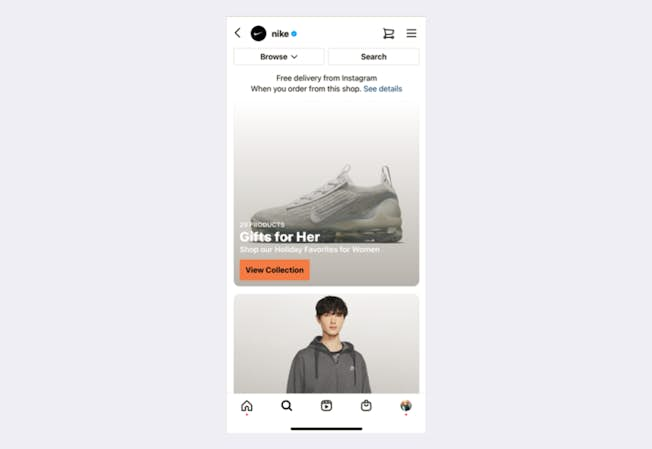
- Integrate shoppable tags as part of your organic content – Don’t just rely on a user clicking on your shop tab. Feature UGC along with shoppable tags to demonstrate authenticity and create social proof in your brand. Answer customer questions swiftly and offer valuable and interesting content to make your shop more attractive to visit.
London coffee shop brand Grind integrates shoppable tags into organic content in a natural way on Instagram, which adheres to the overall aesthetic of the page.
- Reach out to influencers - As we all know, influencers can be powerful so it’s worth building an influencer marketing strategy as part of your social commerce. Enlist influencers to help spread the word of products in your shops. This could be paid-for promotion or gifted/PR products that you offer influencers in return for content. Influencers can be found manually by researching Instagram and TikTok and using relevant hashtags.
Note: Select influencers with high engagement rates – as well as noting their follower numbers. Some influencers require payment in return for content creation and promotion. If you pay – they must correctly label their content with the word ‘advert’ to adhere to promotional guidelines. Measure the effectiveness of their activity by providing them with tracked links to share.
- Promote content with shoppable tags as adverts - Advertisers on Facebook or Instagram can run existing shoppable posts as ads with product tags or create new ads with product tags in Ads Manager. When you run an existing shoppable post as an ad, the ad creative will feature the product tags from the organic post. Utilize the new ‘Shop’ placement within Facebook Ads Manager to showcase products on the main Shopping page on Instagram.
Note: Select an audience and budget that is most appropriate for your brand and test the effectiveness of advertising using shoppable posts to see if it's effective.
How to get started with social commerce
A good place to start is to review which platforms you’d like to use for social commerce and see if your products meet the merchant requirements of each platform.
If your products are eligible, go through the steps to create your shops, taking good care to create attractive easy-to-navigate social shops with plenty of product detail. Consider utilizing influencers, advertising, and leverage your organic content to drive new followers, and all-important conversions into purchases.
Online consumer behavior suggests that customers are more open to trying new ways of shopping since the global Covid-19 pandemic began. The social media platforms are heavily investing in more opportunities to integrate social commerce opportunities as part of their experiences. If you’re looking to increase product sales, then considering your social commerce offering makes sense to do sooner rather than later.
Use the Power of Social Media & Social Commerce in Your Marketing
Become an in-demand social media marketer with knowledge of social strategy, social research and social content. Enroll in DMI’s Professional Diploma in Social Media Marketing to gain a working knowledge of all social media platforms from YouTube to Instagram to LinkedIn along with social customer service and social video.
Related
Upgrade to Power Membership to continue
your access to thousands of articles, toolkits, podcasts, lessons and much much more.
Become a Power Member- Login
- View Courses
- - - -
- Courses
- Resources
- - - -
- My Account
- Change Password
- Logout






